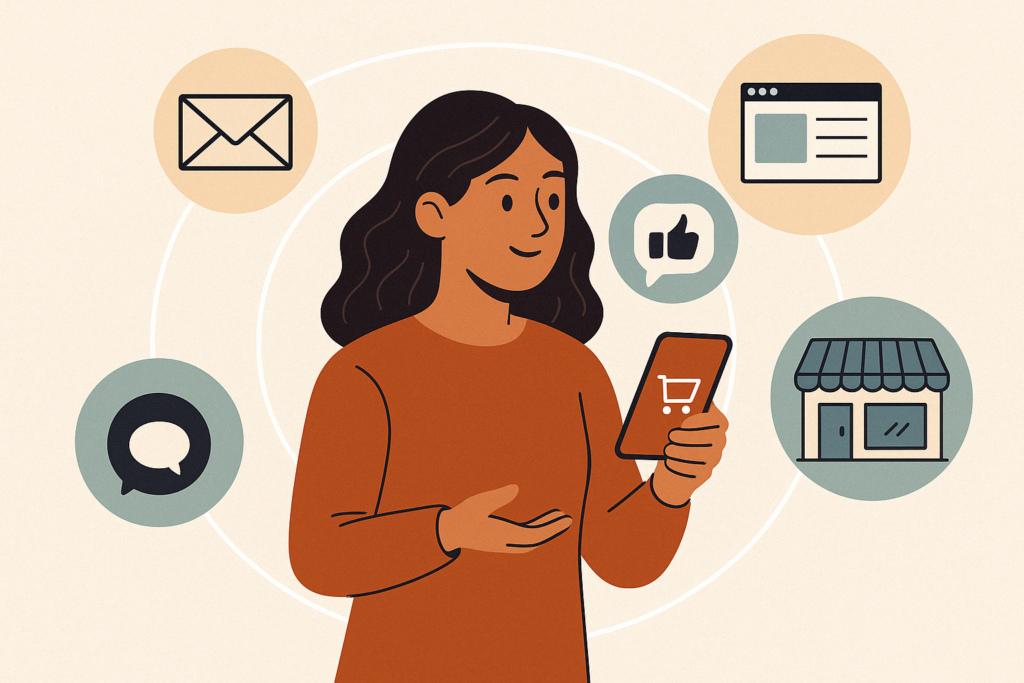
Crafting a Seamless Cross-Channel Customer Experience
The customer doesn’t think in channels—they think in experiences. Whether they discover your brand via a TikTok ad, click a Google Shopping link, or walk into a retail store, they expect each interaction to feel personal, consistent, and connected. Brands that fail to unify these touchpoints don’t just risk losing a sale—they risk losing the customer entirely.
A unified, cross-channel experience isn’t just good UX—it’s bottom-line smart. According to Salesforce’s latest State of the Connected Customer report, 83% of customers expect to interact with someone immediately when they contact a company, and 73% expect consistency across departments (source). So how do you deliver that level of seamless integration at scale?
Let’s break it down—not by channel, but by strategy.
The Foundation: Build Around the Customer, Not the Channel
Years ago, a top beauty subscription brand came to Hawke Media struggling to connect its booming TikTok presence with poor email retention and an underperforming website. What we uncovered was simple: the brand had optimized each channel in a silo, leaving the customer to bridge the experience gaps on their own. The fix? A unified customer journey built around moments of intent—not platforms.
Key Action:
Map the customer journey from discovery to repeat purchase. Identify key micro-moments—searching for reviews, adding to cart, post-purchase check-ins—and align messaging, offers, and content across all touchpoints accordingly. Use tools like Hawke.AI to monitor real-time behavior and performance.
Tactic 1: Establish a Single Source of Truth (Your CDP or CRM)
Without a centralized data repository, integration is impossible. That means syncing first-party data across platforms—your email provider, ad channels, POS, web analytics, customer service platforms—so each team works from the same playbook.
A fashion e-comm client we worked with had loyal in-store shoppers and massive seasonal email spikes—but no way to tie offline purchases to online behavior. Implementing a custom CRM sync across Shopify, Klaviyo, and Square allowed us to recognize in-store VIPs in email and serve them loyalty-tiered content. Cart abandonment rates dropped 14% quarter over quarter.
Key Action:
Invest in a Customer Data Platform (CDP) or fully integrated CRM. Ensure your customer profiles merge identities across email addresses, device IDs, and loyalty numbers. Use dynamic attributes like last purchase, preferred channel, or AOV to personalize experiences across touchpoints.
Tactic 2: Implement Universal Messaging Principles
Every touchpoint is a conversation. And if your brand voice shifts between platforms like a different actor reading the same script, customers will notice. Worse, they’ll trust you less.
It’s not enough for your social team to be witty and your email marketing to be practical—they must speak from the same core narrative. This is where a messaging matrix comes in handy: a living document that maps your brand voice, tone, and value props across formats, from video scripts to chat support macros.
Key Action:
Create a messaging matrix. Break down your brand tone (e.g., “aspirational but grounded,” “expert but not elitist”) across use cases like email, paid social, product packaging, and customer support. Distribute it to every team and enforce consistency.
Tactic 3: Use Triggered Workflows to Create Momentum
Timing is everything. A welcome email 15 minutes after sign-up? Late. A Facebook retargeting ad for a product the customer just bought? Redundant. True cross-channel sophistication means knowing what to say and when.
That same beauty brand mentioned earlier? We built a lifecycle marketing program with triggered flows based on browsing behavior, UTM source, and geo-location. When someone engaged with a product quiz via Instagram, they were instantly added to a tailored email sequence and excluded from top-funnel ads. The result? 3x higher conversion rates on that cohort than any static audience segment.
Key Action:
Connect behavior across channels using UTMs, pixel tracking, and server-side event tracking. Build dynamic automation that reflects real-time user behavior, not just fixed calendar campaigns. Klaviyo, Customer.io, and Iterable offer these capabilities at various levels of complexity.
Tactic 4: Bridge Offline and Online Experiences
For omnichannel brands, the biggest missed opportunity is failing to integrate physical and digital touchpoints. Retail staff don’t know what ads a customer clicked. Digital teams don’t see that someone returned an item in-store. This not only disrupts experience but hampers personalization.
A high-end cookware brand we advised installed QR-enabled receipts and NFC packaging, which linked to recipe content, registration flows, and personalized follow-up emails. Returns dropped. LTV rose. All by making the purchase packaging feel like an extension of their digital experience.
Key Action:
Use scannable QR codes or NFC tech on packaging, signage, and receipts to link in-store purchases with digital experiences. Create unique landing pages tied to each retail interaction, and tailor follow-up email/SMS accordingly.
Tactic 5: Let Your Customer Support Team Be a Channel
Don’t overlook the power of post-purchase conversations. The people emailing your support team or DMing on Instagram aren’t just problems to solve—they’re stories waiting to be heard. And often, they’re your best insight into experience breakdowns.
One of our clients in the luxury home goods space began tagging support tickets with keywords tied to purchase intent, confusion, or delay. These tags were piped into Slack alerts for marketing and product. Within a quarter, we’d launched three UX updates and one campaign optimization, reducing churn by 9%.
Key Action:
Treat support conversations as first-party data. Integrate tools like Gorgias, Zendesk, or Intercom with your CDP to surface patterns in feedback. Turn those insights into proactive campaigns: How-to videos, FAQ flows, and self-serve tools.
Wrapping It Up
A seamless cross-channel experience isn’t built overnight. It’s forged in the trenches—by connecting the dots, testing the flows, and listening to the signals between the lines. And most importantly, it’s never truly finished. Because as customers evolve, so do their expectations.
Integration isn’t about perfection. It’s about continuity. Because in a world where the average customer uses at least 10 channels to communicate with brands, the companies that win won’t just show up—they’ll show up as one.